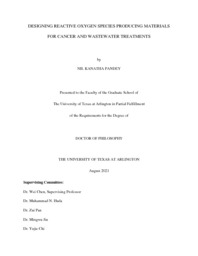
ATTENTION: The works hosted here are being migrated to a new repository that will consolidate resources, improve discoverability, and better show UTA's research impact on the global community. We will update authors as the migration progresses. Please see MavMatrix for more information.
Show simple item record
| dc.contributor.advisor | Chen, Wei | |
| dc.creator | Pandey, Nil Kanatha | |
| dc.date.accessioned | 2023-06-27T23:34:48Z | |
| dc.date.available | 2023-06-27T23:34:48Z | |
| dc.date.created | 2021-08 | |
| dc.date.issued | 2021-08-13 | |
| dc.date.submitted | August 2021 | |
| dc.identifier.uri | http://hdl.handle.net/10106/31342 | |
| dc.description.abstract | This dissertation is focused on using nanotechnology to improve conventional photodynamic therapy (PDT) and advanced oxidation processes (AOPs) for cancer and wastewater treatments, respectively. Even though PDT has a great potential for cancer treatment, the insufficient penetration depth of the external light source and hypoxic nature of the tumor microenvironment severely hinder PDT’s applications in clinical settings. Fortunately, microwaves (MWs) offer a potential opportunity to overcome these limitations. In the first part of the dissertation, a facile synthesis method of copper-cysteamine (Cu-Cy) nanoparticles is discussed, and their reactive oxygen species (ROS) production and cancer cell killing performances upon MW exposure are investigated. Our results demonstrate that the new synthesis method not only decreased the synthesis time but also improved the efficacy of Cu-Cy nanoparticles for cancer treatment. Another disadvantage of conventional PDT is that conventional photosensitizers usually suffer from aggregation-caused fluorescence quenching and a remarkable reduction in ROS generation in aqueous solutions. Intriguingly, aggregation-induced emission lumiogens (AIEgens) offer a potential opportunity to overcome this drawback. Accordingly, two AIEgens (TPEPy-I and TPEPy-PF6) were designed, and their ROS production performance and cancer cell killing capabilities upon MW radiation were explored in a systematic way. For the first time, we found that these two AIEgens can generate ROS upon MW irradiation and can efficiently destroy cancer cells. ROS also plays a vital role to degrade organic pollutants contained in wastewater. The third part of the dissertation investigates the oxidative degradation of various toxic and nonbiodegradable organic pollutants using Cu-Cy nanoparticles. We discovered that the catalytic effect of Cu-Cy can be enhanced upon MW exposure. Our findings showed that Cu-Cy nanoparticles are promising heterogeneous Fenton-like catalysts for wastewater treatment. Considering the facile and green synthesis method of Cu-Cy and the ability to degrade wide varieties of organic contaminants in a relatively short time, it is believed that this work provides a simple yet efficient and economical catalyst ideal for the removal of toxic organic pollutants from wastewater. Overall, this dissertation would be beneficial to the further development of fundamental research in the field of “ROS Science,” which is an emerging scientific discipline. | |
| dc.format.mimetype | application/pdf | |
| dc.language.iso | en_US | |
| dc.subject | Reactive oxygen species | |
| dc.subject | ROS | |
| dc.subject | Singlet oxygen | |
| dc.subject | Hydroxyl radical | |
| dc.subject | Cancer | |
| dc.subject | Photodynamic therapy | |
| dc.subject | Microwaves | |
| dc.subject | Microwave-induced photodynamic therapy | |
| dc.subject | Microwave dynamic therapy | |
| dc.subject | Thermal ablation | |
| dc.subject | Wastewater treatment | |
| dc.subject | Advanced oxidation processes | |
| dc.subject | Fenton-like reaction | |
| dc.subject | Catalysts | |
| dc.subject | Copper-cysteamine | |
| dc.subject | Aggregation-induced emission luminogens | |
| dc.title | DESIGNING REACTIVE OXYGEN SPECIES PRODUCING MATERIALS FOR CANCER AND WASTEWATER TREATMENTS | |
| dc.type | Thesis | |
| dc.date.updated | 2023-06-27T23:34:48Z | |
| thesis.degree.department | Physics | |
| thesis.degree.grantor | The University of Texas at Arlington | |
| thesis.degree.level | Doctoral | |
| thesis.degree.name | Doctor of Philosophy in Physics and Applied Physics | |
| dc.type.material | text | |
| dc.creator.orcid | 0000-0002-9116-1488 | |
| local.embargo.terms | 2023-08-01 | |
| local.embargo.lift | 2023-08-01 | |
Files in this item
- Name:
- PANDEY-DISSERTATION-2021.pdf
- Size:
- 9.095Mb
- Format:
- PDF
This item appears in the following Collection(s)
Show simple item record


